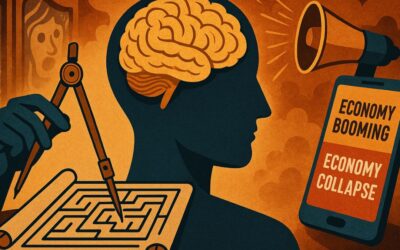Introduction
In this eye-opening episode of English Plus, host Danny delves into the exciting world of educational technology. From its humble beginnings with the invention of the printing press to cutting-edge innovations like AI and VR, explore how technology is revolutionizing the way we teach and learn. Join us as we discuss the benefits and challenges of integrating technology in the classroom, share insights from an educational technology innovator, and reveal how we can prepare students for success in the digital age. Tune in for a fascinating exploration of the role of technology in education and pick up some valuable English vocabulary along the way!
Audio Episode
Interactive Transcript
Text Transcript
Hello and welcome, dear listeners, to another episode of the English Plus Podcast! I’m your host, Danny, and today we’re diving into a topic that has a huge impact on our daily lives: the role of technology in education. Get ready, because we’re about to explore how technology is changing the way we learn, teach, and interact in the educational world.
Now, whether you’re a student, teacher, or just someone who’s curious about the topic, understanding the effects of technology on education is crucial in today’s fast-paced, digital world. So, buckle up and let’s embark on this ed-tech journey together.
[transition music]
Danny:
Alright, folks, let’s take a quick trip down memory lane and explore the history of technology in education. You know, it’s fascinating to see just how far we’ve come since the invention of the printing press back in the 15th century. I mean, I can’t even imagine life without my trusty laptop!
But let’s not get ahead of ourselves. The printing press, invented by Johannes Gutenberg, was a game-changer for education because it made books more accessible and affordable, which in turn, helped spread knowledge and literacy. I bet Gutenberg would be amazed to see how his invention has evolved into the digital gadgets we have today!
Now, let’s fast-forward a bit and talk about some key milestones in the development of educational technology. In the 20th century, we saw the introduction of the radio, television, and eventually, the computer, all of which transformed the way we access information and learn. Who remembers those bulky, beige computers from the ’90s? Ah, the nostalgia!
With the rise of the internet and the World Wide Web in the early ’90s, we saw an explosion of online learning opportunities, educational software, and resources for both students and teachers. And let’s not forget about the advent of smartphones, tablets, and other portable devices, which have made learning on-the-go easier than ever.
These advancements in technology have had a massive impact on the way we learn. They’ve opened up new possibilities for collaboration, communication, and access to resources that were previously unimaginable. Long gone are the days of chalkboards and dusty encyclopedias; now, we’ve got interactive smart boards and the whole world at our fingertips!
But that’s just the beginning, my friends. In our next section, we’ll dive deeper into the current state of educational technology and how it’s shaping the future of learning. So, stay tuned!
[transition music]
Danny:
Okay, everyone, it’s time to take a closer look at the current state of educational technology, and let me tell you, it’s pretty amazing what’s happening in classrooms all around the world!
First up, let’s chat about digital devices in the classroom. Remember when the most high-tech gadget in class was the overhead projector? Well, those days are long gone! Nowadays, we’ve got tablets, smart boards, and even virtual reality headsets making their way into schools.
Tablets have become a staple in many classrooms, allowing students to access textbooks, educational apps, and the internet with just a few swipes. Teachers can also use tablets to manage lesson plans, assignments, and even monitor student progress. It’s like having a little digital assistant right at your fingertips!
And then we have smart boards, which are like the love child of a traditional whiteboard and a giant touchscreen tablet. These interactive displays let teachers and students write, draw, and manipulate digital content, making lessons more engaging and interactive. It’s like magic, I tell you!
But it’s not just about tablets and smart boards. There are tons of other digital devices out there that are revolutionizing the classroom experience, from 3D printers to e-readers, and even robots that can help teach coding and other STEM subjects. The possibilities are virtually endless!
So, as you can see, the current state of educational technology is quite impressive, and it’s only going to get more advanced from here. Stay tuned as we continue exploring other aspects of ed-tech in the next part of our discussion!
[transition music]
Danny:
Now, let’s shift gears and talk about another fantastic development in educational technology: online learning platforms and Massive Open Online Courses, or MOOCs, as they’re affectionately known.
Online learning platforms have truly revolutionized the way we learn. These digital platforms offer a wealth of resources, from video lectures and interactive quizzes to discussion forums and even one-on-one tutoring. Some popular platforms you might have heard of include Khan Academy, Coursera, and Udacity. And the best part? You can learn at your own pace, anytime, anywhere – all you need is an internet connection and a sense of curiosity!
Now, MOOCs are a specific type of online learning experience that offer free or low-cost courses on a wide range of subjects, often provided by top universities and institutions. MOOCs have become incredibly popular in recent years, partly because they make high-quality education accessible to people all over the world, regardless of their financial or geographical constraints. How cool is that?
With MOOCs, you can study anything from computer programming to art history, and even earn certificates or credits towards a degree, all from the comfort of your own home. And let’s not forget the fantastic opportunities for networking and collaboration that online learning platforms provide, connecting learners from all walks of life.
So, whether you’re looking to upskill, explore new interests, or just satisfy your insatiable appetite for knowledge, online learning platforms and MOOCs have got you covered. The future of education is truly online, my friends! But hold on, there’s more to discover in the world of ed-tech, so don’t go anywhere!
[transition music]
Danny:
Alright, folks, brace yourselves because we’re about to enter the exciting world of virtual and augmented reality in education! If you thought tablets and smart boards were cool, just wait until you hear about this cutting-edge technology.
Virtual reality, or VR, is an immersive technology that allows users to step into a computer-generated world using a headset and sometimes additional accessories like gloves or controllers. Imagine being able to explore ancient Rome, dive into the depths of the ocean, or even walk on the surface of Mars, all without leaving your classroom! With VR, students can engage in experiential learning, which can help them better understand complex concepts and retain information more effectively.
Now, augmented reality, or AR, is slightly different. Instead of immersing users in a completely virtual environment, AR overlays digital information onto the real world, usually through the use of a smartphone or tablet. For example, students can point their devices at a textbook page and watch as 3D models, animations, or additional information pop up on the screen. It’s like having a magical, interactive textbook!
Both VR and AR have the potential to revolutionize education by creating immersive, engaging learning experiences that cater to different learning styles. Teachers can use these technologies to make lessons more interactive and memorable, while students can explore new worlds and gain a deeper understanding of the subjects they’re studying.
So, get ready to don your VR headsets and AR glasses, because the future of education is looking incredibly immersive! But before you go exploring virtual worlds, stick around for more insights on the ever-evolving world of educational technology!
[transition music]
Danny:
Now that we’ve delved into the virtual and augmented realms, let’s talk about another significant development in educational technology: the rise of adaptive learning systems.
Adaptive learning systems are essentially digital platforms that use algorithms and data to customize learning experiences based on a student’s unique needs, abilities, and interests. Think of it as a personalized tutor that can monitor your progress, identify your strengths and weaknesses, and adjust the content and pace of your learning accordingly. It’s like having a personal trainer, but for your brain!
These systems work by continuously gathering data on a student’s performance, such as their response time, the difficulty level of questions they’re answering, and their overall progress. Based on this data, the system can then tailor the learning experience to better suit the individual’s needs, making it more effective and engaging.
One of the significant benefits of adaptive learning systems is that they can help bridge gaps in knowledge and understanding, ensuring that no student is left behind. They also encourage a more personalized learning experience, allowing students to learn at their own pace and focus on the areas where they need the most improvement.
The rise of adaptive learning systems is a testament to the power of technology in transforming education and creating more inclusive, individualized learning experiences for everyone. So, as we continue to embrace the digital age, expect to see even more innovative solutions that cater to the diverse needs of learners around the world.
But don’t go away just yet! We still have more to discuss about the impact of technology on students and teachers, so stay tuned!
[transition music]
Danny:
Alright, my tech-savvy friends, let’s move on to another fascinating aspect of educational technology: the role of artificial intelligence, or AI, in personalized learning. We’re talking about machines that can learn, adapt, and help us become better learners. It’s like something straight out of a sci-fi movie, but it’s happening right now!
Artificial intelligence has the potential to take personalized learning to a whole new level. By using complex algorithms and machine learning techniques, AI-powered systems can analyze vast amounts of data on student performance, preferences, and learning styles. This information can then be used to create highly customized learning paths, resources, and feedback for each student.
For example, an AI-powered learning platform might suggest specific resources or activities based on a student’s previous performance, interests, or even the time of day when they’re most focused. It could also provide instant feedback on assignments, identifying areas for improvement and suggesting targeted strategies to help students master challenging concepts.
In addition to personalizing the learning experience, AI can also help teachers by automating time-consuming tasks like grading and administrative work. This frees up more time for educators to focus on what they do best: teaching and engaging with their students.
Of course, the use of AI in education also raises important questions about ethics, privacy, and the role of human educators in the learning process. As we continue to explore the potential of AI in personalized learning, it’s crucial to strike a balance between harnessing the power of technology and preserving the human touch that makes education truly meaningful.
So, keep an eye on AI, folks – it’s undoubtedly going to play a significant role in the future of education. But for now, let’s move on to the impact of technology on students and teachers. Don’t go away!
[transition music]
Danny:
Alright, now that we’ve explored some of the latest developments in educational technology, let’s dive into the impact of technology on students and teachers. There are both benefits and challenges, but for now, let’s focus on the positives, because who doesn’t love a bit of good news?
First, one of the most significant benefits of technology in education is the unprecedented access to information and resources. With just a few clicks, students can find answers to their questions, research topics in-depth, and access a treasure trove of learning materials, like videos, articles, and interactive quizzes. It’s like having the world’s largest library right at your fingertips!
Second, technology can lead to increased engagement and motivation among students. Let’s face it; traditional textbooks and lectures can sometimes be, well, a bit dull. But with interactive learning tools, multimedia content, and gamification elements, technology can help make learning more fun, engaging, and relevant to students’ interests.
Third, as we’ve discussed earlier, technology enables personalized learning experiences. By catering to individual learning styles, needs, and preferences, technology can help ensure that every student has the opportunity to reach their full potential. It’s like having a custom-tailored suit for your brain!
Lastly, technology opens up a world of collaboration and communication opportunities for both students and teachers. From online discussion forums and video conferences to collaborative projects and virtual study groups, technology enables learners to connect with their peers and educators in ways that were once impossible.
So, as you can see, there are plenty of reasons to be excited about the role of technology in education. But of course, with every silver lining comes a cloud, and that’s why we’ll also be discussing the challenges of technology in education next. Stay tuned!
[transition music]
Danny:
Now that we’ve covered the bright side of technology in education, it’s time to delve into some of the challenges that come with incorporating tech into the learning process. It’s important to recognize that while technology can be a powerful tool for learning, it’s not without its drawbacks.
First up is the digital divide and accessibility issues. Not all students and schools have equal access to the latest technology, which can exacerbate existing inequalities in education. This means that we need to work towards ensuring that all students have the opportunity to benefit from the advancements in educational technology, regardless of their socioeconomic background.
Second, there’s the potential issue of overreliance on technology. While tech can be incredibly useful, it’s important to remember that it’s just one part of the educational puzzle. We need to strike a balance between using technology effectively and maintaining the human touch that makes teaching and learning so special. After all, technology should be a tool to enhance education, not a replacement for human interaction.
Third, let’s talk about the potential for distraction. We all know how easy it is to lose focus when scrolling through social media or playing games on our devices. So, it’s essential for both students and teachers to learn how to use technology responsibly and stay focused on the task at hand, rather than getting lost in the digital rabbit hole.
Finally, we have privacy and security concerns. With so much personal information being shared and stored online, it’s crucial to ensure that students’ and teachers’ data is protected. Schools and educational platforms must implement robust security measures and educate users about best practices for protecting their personal information.
So, there you have it – some of the challenges that come with integrating technology into education. It’s important to be aware of these issues and work towards addressing them, so that we can harness the full potential of technology as a tool for learning. In the next segment, we’ll discuss how teachers can adapt to and embrace the technological shift. Stay with us!
[transition music]
Danny:
As we continue our journey into the world of educational technology, it’s time to talk about how teachers can adapt to and embrace the technological shift. After all, teachers are the heart and soul of the educational process, and their role is more important than ever in this rapidly changing landscape.
First and foremost, it’s essential for teachers to have a growth mindset and be open to learning about new technologies. This means staying informed about the latest developments in ed-tech, participating in professional development opportunities, and not being afraid to ask questions or seek help when needed. Remember, we’re all learners here, so it’s okay to embrace that inner curiosity and explore new tools and techniques.
Second, it’s important for teachers to be intentional about how they integrate technology into their teaching. This means carefully evaluating which tools and resources will genuinely enhance the learning experience and support learning objectives, rather than using technology for technology’s sake. It’s also a good idea to start small, experimenting with one or two new tools before diving headfirst into the digital deep end.
Next, teachers should strive to create a balanced learning environment that incorporates both traditional and digital teaching methods. While technology can be incredibly powerful, it’s important not to overlook the value of face-to-face interactions, hands-on activities, and other non-digital learning experiences. The key is to strike a balance that meets the diverse needs and preferences of all learners.
Finally, teachers can serve as role models for responsible technology use. This means demonstrating good digital citizenship, teaching students about online safety and privacy, and fostering a culture of respect and responsibility when using technology in the classroom.
By staying curious, being intentional, and maintaining a balanced approach, teachers can successfully navigate the technological shift and harness the full potential of ed-tech to enhance their students’ learning experiences. Now, let’s move on to talking about preparing for the future of education. Don’t go anywhere!
[transition music]
Danny:
Alright, folks, as we approach the end of today’s episode, let’s spend some time discussing how we can prepare for the future of education. After all, technology is only going to play an even bigger role in the coming years, so it’s essential to be ready to adapt and grow.
First up, let’s talk about the importance of digital literacy and computational thinking. In today’s digital age, it’s crucial for students to not only be able to use technology effectively but also understand how it works and how to solve problems using computational methods. By fostering digital literacy and computational thinking skills, we can empower students to become not just consumers of technology but creators and innovators as well.
As we’ve mentioned before, promoting a balance between traditional and digital learning methods is key. While technology offers incredible opportunities for personalized, interactive, and engaging learning experiences, it’s important not to lose sight of the value of face-to-face interactions, hands-on activities, and other non-digital teaching methods. A balanced approach will ensure that students develop a well-rounded set of skills and knowledge.
In an ever-changing world, critical thinking and problem-solving skills are more important than ever. We need to encourage the development of these skills by providing students with opportunities to tackle complex, real-world problems and think critically about the information and ideas they encounter. This can be done through project-based learning, inquiry-based activities, and other teaching strategies that promote deep thinking and active engagement.
Finally, fostering a growth mindset in the age of technology is essential. With the rapid pace of change and the constant influx of new tools and resources, it’s important for both students and educators to embrace the idea that we’re all lifelong learners. This means being open to new ideas, willing to take risks, and recognizing that failure is an opportunity to learn and grow.
By focusing on these key areas, we can help prepare students for the future of education and ensure that they’re equipped with the skills, knowledge, and mindset needed to thrive in a technology-driven world. And now, as we wrap up today’s episode, let’s move on to something special we do in English Plus Podcast. Coming up next. A look into the keywords from this episode, so don’t go anywhere. I’ll be right back.
[transition music]
Danny:
Well, here come our keywords. This is English Plus, after all, so let’s take a moment to explore some of the keywords and phrases from today’s episode. I’ll explain their meanings and remind you of the context in which they were used. Here we go:
- Educational technology (Ed-tech): The use of technology to support teaching and learning. We discussed various forms of educational technology throughout the episode, including AI, VR, and adaptive learning systems.
- Printing press: A device that made mass printing possible, revolutionizing education by making books and knowledge more accessible. We talked about the printing press in our brief history of technology in education.
- Massive Open Online Courses (MOOCs): Large-scale online courses that are accessible to anyone with an internet connection. We discussed MOOCs as part of the current state of educational technology.
- Virtual reality (VR): A computer-generated simulation of a three-dimensional environment that users can interact with using special equipment. We explored how VR is being used in education to create immersive learning experiences.
- Augmented reality (AR): The integration of digital information with the user’s environment in real-time. We mentioned AR as another exciting development in educational technology.
- Adaptive learning systems: Educational programs that use algorithms to customize learning experiences for individual students based on their needs, preferences, and performance. We discussed adaptive learning systems as a cutting-edge development in ed-tech.
- Artificial intelligence (AI): The development of computer systems that can perform tasks that typically require human intelligence, such as learning and problem-solving. We talked about AI’s role in personalized learning.
- Digital divide: The gap between those who have access to modern information technology and those who don’t. We touched on this challenge when discussing the integration of technology in education.
- Digital literacy: The ability to use digital technology effectively and responsibly. We emphasized the importance of digital literacy when preparing for the future of education.
- Computational thinking: The ability to understand and solve problems using computational methods and concepts. We mentioned computational thinking as another essential skill for students in the digital age.
- Growth mindset: The belief that intelligence and abilities can be developed through dedication and hard work. We talked about fostering a growth mindset in the age of technology.
- Project-based learning: A teaching method that involves students working on real-world projects to develop skills and knowledge. We mentioned this as a way to encourage critical thinking and problem-solving skills.
- Inquiry-based activities: Learning activities that involve students asking questions, investigating, and exploring problems. We suggested inquiry-based activities as another way to promote critical thinking skills.
- Digital citizenship: The responsible and ethical use of technology. We talked about the importance of teaching students about digital citizenship and online safety.
- Hands-on activities: Learning experiences that involve students actively engaging with and manipulating materials or objects. We discussed the value of hands-on activities when promoting a balance between traditional and digital learning methods.
And there you have it! Now you’re not only more informed about the role of technology in education, but you’ve also expanded your English vocabulary!
[transition music]
Danny:
Well, folks, we’ve covered a lot of ground in today’s episode. We started with a brief history of technology in education, from the invention of the printing press to the modern era. We then explored the current state of educational technology, discussing digital devices in the classroom, online learning platforms, virtual and augmented reality, adaptive learning systems, and the role of AI in personalized learning.
We also discussed the impact of technology on students and teachers, highlighting both the benefits and challenges of integrating technology into education. We also talked about how to prepare for the future of education by focusing on digital literacy, computational thinking, critical thinking, and fostering a growth mindset.
So, as we wrap up, let’s remember that technology has the potential to transform education in incredible ways, but it’s up to us – educators, parents, and stakeholders – to embrace it as a tool for enhancing learning. By staying informed, adapting to change, and focusing on what’s best for our students, we can create an education system that prepares them for success in the digital age.
Thank you all for tuning in to this episode of English Plus. We hope you found it both informative and enjoyable.
As always, we appreciate your support and would love to hear your thoughts on today’s topic. Don’t forget to subscribe, leave a review, and share the podcast with your friends and colleagues. Until next time, this is Danny, signing off. Keep learning, stay curious, and see you in the next episode of English Plus!










0 Comments